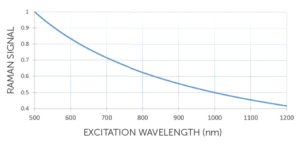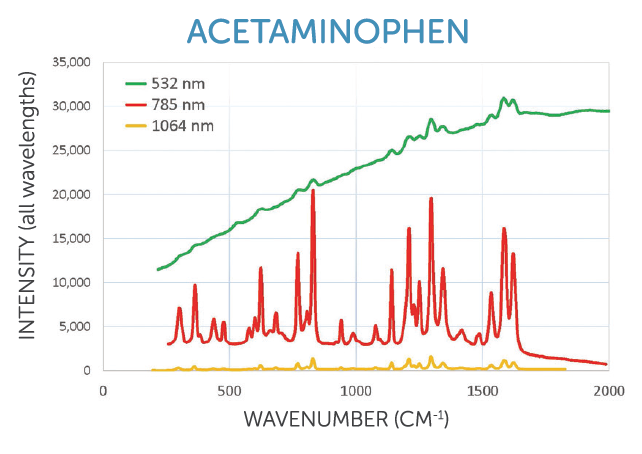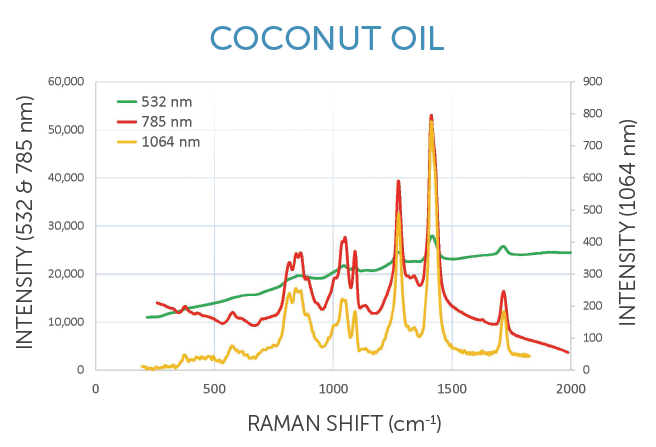A key virtue of Raman spectroscopy is that each and every wavelength of laser can be utilized to create a Raman spectrum, provided appropriate laser intensity is delivered to the sample.
Yet, with Raman systems available from the UV through NIR, there is the challenge in knowing what excitation wavelength will result in the best quality Raman spectrum for a given sample. This leads to the question, how can this be identified prior to making any costly investment in a system? Here are some of the factors worth considering when pursuing the ideal excitation wavelength (λex):
Excitation Efficiency
This scales conversely as λex4, making a compelling argument for visible or even UV excitation. However, in actuality, other factors frequently dominate the choice of λex, from the other considerations below to the high-cost and limited lifetime of compact UV lasers.

Optical Filtering
The use of a short λex will necessitate the use of a steeper optical filter to eradicate scattered laser light for samples with Raman peaks of interest near the point of reaching the laser line. For Raman peaks at less than 200-250 cm-1, a customized probe or spectrometer configuration may be necessary.
Sample Sensitivity
Sample heating can be a problem for visible λex, especially when considering highly pigmented or darkly colored samples. This can damage and impair the sample, or induce changes in the structure for fragile biological or organic samples. Careful attention must be given to excitation power in order to prevent sample burning or degradation.
Spectral Range and Resolution
A sample’s Raman spectrum will encompass a smaller wavelength range at shorter λex. Raman peak widths will also show up narrower as λex decreases, thus demanding the improved resolution of the spectrometer to resolve two adjacent Raman peaks. The spectral resolution is frequently crucial for research applications rather than for materials identification, which often observes the fingerprint region from 200-2000 cm-1, known as the fingerprint region.
Minimizing Fluorescence
Of all the factors to be taken into account when choosing an excitation wavelength, sample fluorescence is possibly the most crucial. This is due to the fact a shorter λex has an increased chance of exciting an electronic transition in the sample, especially where organic samples or biomaterials are concerned.
This may consequently lead to an increase in the background or baseline, due to the inherent fluorescence of the sample when excited by visible light. The signal to noise of the spectrum may be reduced, or Raman peaks may be dwarfed in relation to the background. Fluorescence is almost exclusively suppressed when using NIR excitation, yet, the cost of the system increases while sensitivity goes down.
So, why not simply subtract the fluorescence background? Photobleaching of the sample can provoke background fluorescence causing it to deteriorate over time. While this can seem appealing, it cannot always be done with great reliability or without modifying the sample.
Given the many factors to be considered, the choice of excitation wavelength may require some experimentation. For samples frequently studied via Raman, however, some preferred wavelengths have emerged. Here, we collect our recommendations:
405 and 532 nm: Best for inorganic samples, strong signal

- Carbon nanomaterials, semiconductors
- Resonance Raman experiments
- SERS (Surface Enhanced Raman spectroscopy)
- Metal oxides, minerals, gemstone analysis
WP 532 ER offers a broader spectral range (200-4000 cm-1)
633-830 nm: Balances signal with fluorescence in organics

- Biological samples, medical diagnostics
- Most chemicals and organic materials
- SERS (Surface Enhanced Raman spectroscopy)
- Pharmaceuticals, narcotics, industrial ingredients
633, 785, and 830 nm excitation options available
1064 nm: Best fluorescence suppression, increased measurement time

- Edible oils, petrochemicals, polymers
- Biological samples, medical diagnostics
- Carbon-based and semiconductor materials
- Inks, pigments, dyes, and varnishes
The high throughput spectrometers from Wasatch Photonics can significantly reduce your data collection time
The proper excitation wavelength makes a major difference where Raman spectroscopy is concerned. Wasatch Photonics provides the knowledge, expertise, and testing to help find your optimal Raman solution.

This information has been sourced, reviewed and adapted from materials provided by Wasatch Photonics, Inc.
For more information on this source, please visit Wasatch Photonics, Inc.